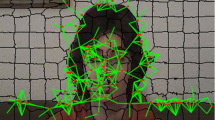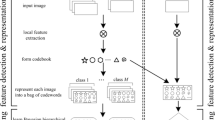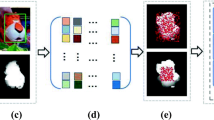Abstract
Most of the part-based methods just use the initial appearance model and feature information of the object. When the object is affected by occlusion, deformation and illumination factors, these methods can not be stable to the tracking object. In this paper, a tracking method is proposed based on keypoint matching and superpixel matching. Our method not only uses the initial feature information of the object, but also uses the feature information between adjacent frames. We use the superpixel to over-segment the candidate region which can be obtained by voting between the globally matched feature points, and then construct superpixel descriptors. The similarity between superpixels is based on the distance of the superpixel feature descriptor. Eventually, the object is selected according to the superpixel vote. Furthermore, we use qualitative and quantitative evaluations to evaluate our method on 18 challenging image sequences. Experimental results show that the proposed method outperforms 6 state-of-the-art tracking algorithms.










Similar content being viewed by others
References
Achanta R, Shaji A, Smith K et al (2012) SLIC superpixels compared to state-of-the-art superpixel methods. IEEE Trans Pattern Anal Mach Intell 34(11):2274–2282
Adam A, Rivlin E, Shimshoni I (2006) Robust fragments-based tracking using the integral histogram. In: 2006 IEEE Computer Society Conference on Computer Vision and Pattern Recognition, New York, NY, USA, 17–22 June 2006. https://doi.org/10.1109/CVPR.2006.256
Babenko B, Yang M-H, Belongie S (2011) Robust object tracking with online multiple instance learning. IEEE Trans Pattern Anal Mach Intell 33(8):1619–1632
Bouachir W, Bilodeau GA (2015) Part-based tracking via salient collaborating features. In: 2015 IEEE Winter Conference on Applications of Computer Vision, Waikoloa, HI, USA, 5–9 Jan 2015. https://doi.org/10.1109/WACV.2015.18
Cai Z, Wen L, Lei Z et al (2014) Robust deformable and occluded object tracking with dynamic graph. IEEE Trans Image Proc 23(12):5497–5509
Derue F, Bilodeau GA, Bergevin R (2016) SPiKeS: superpixel-keypoints structure for robust visual tracking. Computer Vision and Pattern Recognition. https://arxiv.org/abs/1610.07238
Fan H, Xiang J, Zhao L (2016) Robust visual tracking via bag of superpixels. Multimedia Tools Appl 75(14):8781–8798
Gao J, Zhang T, Yang X et al (2017) Deep relative tracking. IEEE Trans Image Process 26(4):1845–1858
Hare S, Saffari A, Torr PHS (2016) Struck: structured output tracking with kernels. IEEE Trans Pattern Anal Mach Intell 38(10):2096–2109
Henriques J F, Rui C, Martins P et al (2015) High-speed tracking with kernelized correlation filters. IEEE Trans Pattern Anal Mach Intell 37(3):583–596
Hürst W, Wezel CV (2013) Gesture-based interaction via finger tracking for mobile augmented reality. Multimedia Tools Appl 62(1):233–258
Kalal Z, Mikolajczyk K, Matas J (2010) Forward-backward error: automatic detection of tracking failures. In: 2010 20th International Conference on Pattern Recognition (ICPR), Istanbul, Turkey, 23–26 Aug 2010. https://doi.org/10.1109/ICPR.2010.675
Kalal Z, Mikolajczyk K, Matas J (2012) Tracking-learning-detection. IEEE Trans Pattern Anal Mach Intell 34(7):1409–1422
Kwon J, Lee KM (2009) Tracking of a non-rigid object via patch-based dynamic appearance modeling and adaptive basin hopping monte carlo sampling. In: IEEE Conference on Computer Vision and Pattern Recognition, 2009. CVPR 2009, Miami, FL, USA, 20–25 June 2009. https://doi.org/10.1109/CVPR.2009.5206502
Leutenegger S, Chli M, Siegwart RY (2011) BRISK: binary robust invariant scalable keypoints. In: 2011 IEEE International Conference on Computer Vision (ICCV), Barcelona, Spain, 6–13 Nov 2011. https://doi.org/10.1109/ICCV.2011.6126542
Li A, Lin M, Wu Y et al (2016) NUS-PRO: a new visual tracking challenge. IEEE Trans Pattern Anal Mach Intell 38(2):335–349
Lowe DG (2004) Distinctive image features from scale-invariant keypoints. Int J Comput Vis 60(2):91–110
Lucas BD, Kanade T (1981) An iterative image registration technique with an application to stereo vision. Proceeding IJCAI'81 Proceedings of the 7th international joint conference on Artificial intelligence, vol 2. Vancouver, BC, Canada, 24–28 Aug 1981
Nebehay G, Pflugfelder R (2014) Consensus-based matching and tracking of keypoints for object tracking. 2014 IEEE Winter Conference on Applications of Computer Vision (WACV), Steamboat Springs, CO, USA, 24–26 Mar 2014. https://doi.org/10.1109/WACV.2014.6836013
Nickels K, Hutchinson S (2002) Estimating uncertainty in SSD-based feature tracking. Image Vis Comput 20(1):47–58
Ren X, Malik J (2007) Tracking as repeated figure/ground segmentation. 2007. CVPR '07. IEEE Conference on Computer Vision and Pattern Recognition, Minneapolis, MN, USA, 17–22 June 2007. https://doi.org/10.1109/CVPR.2007.383177
Wang J, Yagi Y (2014) Many-to-many superpixel matching for robust tracking. IEEE Transactions on Cybernetics 44(7):1237–1248
Wu Y, Lim J, Yang MH (2015) Object tracking benchmark. IEEE Trans Pattern Anal Mach Intell 37(9):1834–1848
Yang F, Lu HC, Yang M-H (2014) Robust superpixel tracking. IEEE Trans Image Process 23(4):1639–1651
Yang X, Wang M, Tao D (2015) Robust visual tracking via multi-graph ranking. Neurocomputing 159:35–43
Yang X, Wang M, Zhang L et al (2016) An efficient tracking system by orthogonalized templates. IEEE Trans Ind Electron 63(5):3187–3197
Yuan Y, Fang J, Wang Q (2014) Robust superpixel tracking via depth fusion. IEEE Trans Circuits Syst Video Technol 24(1):15–26
Zhang T, Ghanem B, Liu S, Ahuja N (2014) Partial occlusion handling for visual tracking via robust part matching. 2014 IEEE Conference on mputer Vision and Pattern Recognition (CVPR), Columbus, OH, USA, 23–28 June 2014. https://doi.org/10.1109/CVPR.2014.164
Zhang T, Ghanem B, Liu S et al (2016) Robust visual tracking via exclusive context modeling. IEEE Transactions on Cybernetics 46(1):51–63
Acknowledgements
This work is partly supported by the National Natural Science Foundation of China under Project code (61672202).
Author information
Authors and Affiliations
Corresponding author
Rights and permissions
About this article
Cite this article
Shen, M., Zhang, Y., Wang, R. et al. Robust object tracking via superpixels and keypoints. Multimed Tools Appl 77, 25109–25129 (2018). https://doi.org/10.1007/s11042-018-5770-6
Received:
Revised:
Accepted:
Published:
Issue Date:
DOI: https://doi.org/10.1007/s11042-018-5770-6




